
|
Home / Articles by Pavel Platonov on the Holy Land / Holy Mount Tabor is the site of the glorious Transfiguration of the Lord. Pavel Platonov
Holy Mount Tabor is the site of the glorious Transfiguration of the LordThis day was celebrated the ancient feast of "booths" or "erection of huts", which were built before the approaching autumn. Jesus Christ went with his disciples Peter, James and John to the "high mountain" to pray. And suddenly, "His face beamed like the sun, and his clothes became white as light." Near the Christ appeared two Old Testament prophet Moses and Elijah. The agitated Peter offered to make three for them.  Symbolic three tabernacles in a Greek Orthodox monastery on the top of Mount Tabor Photos January 26, 2014 © Photo of the orthodox pilgrim center "Russia in colors" in Jerusalem "When he yet spoke, behold, a cloud of light dawned upon them; And behold a voice out of the cloud, saying, This is my beloved Son, in whom I am well pleased; Listen to him. And when they heard, the disciples fell on their faces and were very frightened. But Jesus, having come, touched them and said: "Rise up and do not be afraid." When they lifted up their eyes, they saw no one but Jesus alone. And when they came down from the mountain, Jesus rebuked them, saying, "Do not tell anyone about this vision, until the Son of Man resurrects from the dead" [1]. The tradition of honoring Mount Tabor is the place of the Savior's Transfiguration affirmed at the holy Equal-to-the-Apostles queen Elena in the beginning of the IV century. The earliest references to the reverence of Mount Favor as the site of the Transfiguration of the Savior are known in the writings of the church historian Origen in the III century [2], as well as in the writings of the early teachers of the Church - Cyril of Jerusalem in the IV century [3] and St.. Hieronymus of Stridon in the 5th century [4]. The establishment of the celebration of the Transfiguration of the Lord on Mount Tabor and the Christian pilgrimage to this holy place have an ancient history [6]. 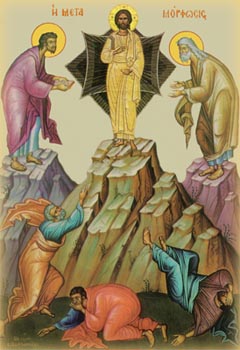 Greek icon of the Transfiguration of the Lord © Photo of the orthodox pilgrim center "Russia in colors" in Jerusalem Yours is the heavens, and Yours is the earth. The universe and its fulfillment You founded. North and Sea You created this: Tabor and Hermon. Your muscle is strong Let Thy hand be strengthened, and Thy right hand will be lifted up. Blessed are the people leading the exclamation O LORD, in the light of thy countenance, And your name will rejoice. (Psalms 88, 12-17) The holy mountain of Tabor was of the utmost importance in the Biblical story. At the time of the Old Testament, it served as the boundary between the allotments of the Israeli tribes of Zebulun in the west, Issachar in the southeast and Naphtali in the north. [7] 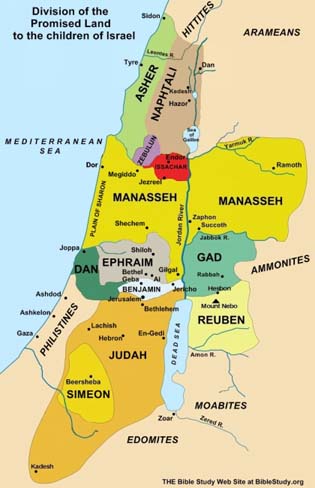 Map of the division of land between the tribes of Israel Majestic in height of 588 meters, a mountain standing alone in the middle of the Izdrelonian valley, located at the intersection of trade routes and occupying an important strategic place has always attracted the attention of the inhabitants of the Holy Land and the various conquerors who come here. 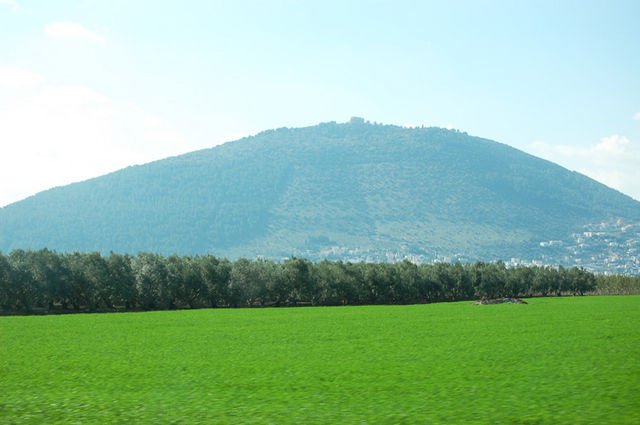 Holy Mount Tabor © Photo of the orthodox pilgrim center "Russia in colors" in Jerusalem  View of Mount Tabor from the valley of Jezreel
Photos January 26, 2014 © Photo of the orthodox pilgrim center "Russia in colors" in Jerusalem 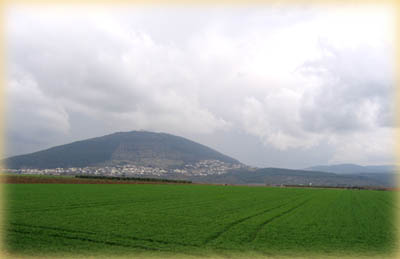 Holy Mount Tabor © Photo of the orthodox pilgrim center "Russia in colors" in Jerusalem Here the fate of the peoples of the Holy Land was decided in the Age of Judges. The Book of Judges narrates about the prophetess Deborah, who stood at the head of the Israelites [8]: "The prophetess, the wife of Lapidof; she lived under the Palm of Devora, ... on Mount Ephraim; and the sons of Israel went to her to go to judgment. " (Judgment 4: 4). Women begin to play a decisive role in the tribal union of the Israelis, beginning with the period of the sister of Moses Mariam and up to Salome Alexandra, who headed the Hasmonean kingdom in the last years of its heyday. [9] Deborah, inspired by God, a freedom fighter, called for Varak, an outstanding knight of the tribe of Naphtali's inheritance, and said to him: "The Lord God of Israel commands you: go up to Mount Tabor and take ten thousand of the sons of Naphtali and sons of the Zebulunites; but I will bring you to the stream of Kishon, Sisera, the commander of Jabin, and the chariots and his populous troops, and I will deliver him into your hands. " (Judgment 4: 6-7) The prophetess of Deborah. Engraving by Gustav Dore The prophecy of Deborah is coming true. The Israelis, led by Barak and a 10,000-strong army, are defeating Sisera, who was at the head of the Canaanite army. Sisara was the commander of the city of Hazor [10]. Despite the numerical superiority of the Canaanites, armed with 900 heavy chariots, they lose the battle to the Israelis. Sisara himself was killed by Ilia - the wife of Heber the Kenyan, in whose tent he tried to hide. According to the Bible, Heber the Kenyan was the leader of a nomadic tribe related to the Israelites [11]. For today, the memory of the prophetess of Deborah is preserved in the name of the Bedouin village, located at the foot of Mount Tabor. The village has the name Deburia in memory of the biblical battle and its inspirer [12]. 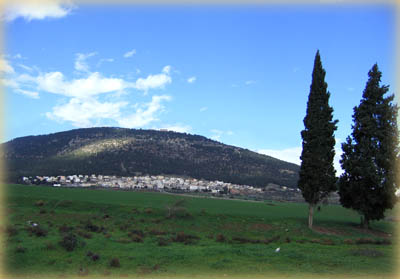 The modern Bedouin village of Deburria at the foot of Mount Tabor © Photo of the orthodox pilgrim center "Russia in colors" in Jerusalem Mount Tabor is associated with yet another battle of the Israelites, only with the Romans. The army of Alexander - the son of Aristobulus suffers from Mount Tabor a heavy defeat to the Romans in 53 BC. at the consul of the Roman Republic - Gnee Pompey the Great [13]. In this battle, more than 10,000 Jews die [14]. In the ancient historian Josephus Flavius [15] Mount Tabor is called Itavirion [16]. 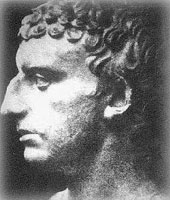 Joseph Flavius Photo sculpture from the site "My Israel" Under Joseph Flavius, the commander of the northern district of the army of the Jewish rebels in AD 67, some of them are fixed in the garrison on Mount Tabor, keeping the defenses there until the food and water supplies are depleted. Flavius in his famous book "The Jewish War" describes this event as follows: "Vespasian, meanwhile, as a side-effect, undertook a campaign against the garrison on Mount Itavirion, lying in the middle between the Great Plain and the Scythopolis. She (Mount Tabor by P. Platonov) rises to a height of 30 stages and is barely accessible from the north side; at its apex the plain is spread over 26 stages, all occupied by fortifications. The voluminous bypass wall Joseph built in 40 days, during which he needed everything, as well as water was delivered from below, since there is no other water above the rainwater. Since a huge crowd of Jews was concentrated here, Vespasian sent Placida against them with 600 horsemen. It was impossible to climb the mountain. In view of this, he beckoned to them downward with a promise of peace and forgiveness. They really came, but in order to set a trap for him. Placid only because of this and made peace talks with them in order to seize them in the open field, and they pretended to surrender voluntarily - also for the purpose of unexpectedly attacking him. Defeated, however, Placid's cunning. As soon as the Jews put weapons into action, he fled for the species and dragged the pursuers far into the field; Here he drew riders on them, destroyed most of them, and cut off the rest of the way to the mountain. They left Itavirion and fled to Jerusalem. Actually, the population of the mountain, already suffering from a lack of water, transferred itself, along with the mountain, into the hands of Placida "[17].The remains of the wall of this garrison, erected by Joseph Flavius from the southeast side of Mount Tabor, have survived to this day. 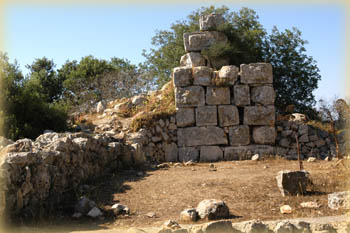 Ruins of ancient buildings on the mountain of Mount Tabor © Photo of the orthodox pilgrim center "Russia in colors" in Jerusalem In the New Testament, the holy mountain Tabor came in as the place of the Transfiguration of the Lord, although in the Gospel there is no mention of the Savior's stay with the disciples on Mount Tabor. There is a mention in the Gospel of Matthew and Mark about the "high mountain" [18]. "After six days, Jesus took Peter, James and John, his brother, and led them to a high mountain alone, and was transfigured before them: and his face shone like the sun, and his clothes became white as light. And, behold, Moses Elijah appeared to them, talking with him. Then Peter said to Jesus: Lord! It is good for us to be here; If you want to make here three tabernacles: One for you, and one for Moses, and one for Elijah. " (Matthew 17: 1-5)The Evangelist Luke mentions only "grief" [19]. The tradition of honoring Mount Tabor is the place of the Savior's Transfiguration affirmed under St. Helena Equal-to-the-Apostles. With her on Mount Tabor, a majestic basilica is built on the site of the Transfiguration and another three churches [20] in the place where the holy apostles Peter, James and John slept during the Transfiguration [21]. The Transfiguration basilica stood at the highest point of the mountain, the second church is somewhat lower, at a close distance from the basilica. In the 5th century, Antoninus the martyr in his work "De locis sanctis" mentions from three churches (tres ecclesiae) [22] on Mount Tabor [23], in commemoration of the fact that the Apostle Peter during the Transfiguration proposed the Savior to build three tents: one Him, one to Moses and one to Elijah [24]. In the VI century, at the fifth Ecumenical Council, it was decided to form a bishopric here, and the prelate remained there even after the invasion of Moslems that followed the century. [25] The pilgrim Arkulph in his message to the biographer in the 7th century also reports on the three churches he saw on Mount Tabor, mentioning the monastery, the hospice house and the monks' cells. [26] Around 720 the Bede the Honorable [27] repeats Arkulph and mentions "a large monastery with grandiose structures surrounded by a wall" [28]. Wilbald (723-726) indicates, in honor of whom these three churches were created: in honor of the Savior, Moses and Elijah. [29] In the 9th century, a long staircase to the top of Tabor ascended in 4340 steps. Pilgrims hiked along it. In the XII century on the Holy Land come crusaders, who make their changes in the provisions of the holy places. Now a significant role in the fate of the Favorsky monasteries, (as well as all in the Holy Land), began to play Latin monks. This is evidenced in his "Walking to the Holy Land" Russian pilgrim XII century Hegumen Daniel. Then there were still no strong differences between Orthodox and Catholics. This is confirmed by the Hegumen Daniel, describing the cordial meeting of his and his companions with Catholic monks:
Hegumen Daniel at a reception with King Baldwin Photo from the site "Institute of Russian Civilization" Participant of the First Crusade (1096-1099) Knight Tankred [32] erected a new chucrh in Tabor, and the foundations of the former ancient structures were used for construction [33]. Pilgrim Zevulf [34], who visited the Holy Land shortly after the first crusade, in his "Journey of Zevul to the Holy Land 1102-1103." as well as Hegumen Daniel, describes in Tabor three churches dedicated to the feast of the Transfiguration and the holy prophets to Moses and Elijah: "About four million miles east of Nazareth is Mount Tabor, entering upon which the Lord was transformed in the eyes of Peter, John and James; it is covered with dense grass and flowers and so rises on a perfectly smooth and green plain, the Galilee, which greatly surpasses the height of all neighboring mountains. Three monasteries built on its top in ancient times stand still: one in the name of Our Lord Jesus Christ, the other in the name of Moses, the third a little further in the name of Elijah, according to Peter's words: "Master, it is good for us to be here; let us make three tabernacles, one for you, one for Moses, and one for Elijah. "[35] In 1177, the Greek pilgrim John Fock was born in Crete and the contemporary of the Byzantine Emperor Manuel Comnen (1143-1180) leaves interesting details about the structures on Mount Tabor, describing the Latin and Orthodox Greek monasteries on the very top of the mountain, emphasizing that the very place of the Transfiguration is in the hands of latinians: "Mount Tabor, the earthly sky, the joy of the soul and the delight of the eyes of Orthodox people. For this mountain is inherent in its divine grace, which exacerbates it, and from this it stirs up spiritual joy. It is a round and moderately elevated hill. On top of it there are two monasteries (μσναι δυο) in which the Christian hermits propitiate the Divine in multilingual hymns (άλλογωσσψ υμνψ), and on the part where the saving Transfiguration of Christ was accomplished, there is a host of Latin monks (λατιων μοναστων), and on our right side the Nazarene sanctified (οι χαθ ημαζ ναξηαιοι) sanctify the sanctified one. For the saving Transfiguration of Christ was accomplished on the top of that hill on which the Latin monastery is also located, and in the altar of its temple there is also the very place where the Lord was transformed in the midst of Elijah, Moses and his three chosen disciples Peter, John and Jacob. The place is fenced with copper bars. And at the point where the feet of the Lord stood, one can see an extremely white marble circle, in the middle of which there is an image of a cross. The unuttered incense, which is poured out of it, sweetens the smell of those who come. However, the monastery is about the distance of the stone, there is a small cave in which Christ, entering after the terrible Transfiguration, commanded the disciples not to tell anyone about the vichy until he resurrected from the dead "[36].The Greek pilgrim accurately reports that the place of the Transfiguration is in the hands of Catholic monks, because, as in the case of Hegumen Daniel, the division between Orthodoxy and Catholicism was not yet fully realized. Both monasteries were tragically tested in the 12th century, when the Muslim commander Salah al-Din [37] in 1183 attacked a Greek Orthodox monastery, whose monks fled the underground passage in the Catholic, which was similar in construction to its fortress. This monastery lasted until the defeat of the Crusaders in the chapter with King Guy de Lusignan in the battle with the Muslims under the leadership of Salah-ad-Din in 1187 [39]. After this, the troops of Salah-ad-Din beat the Christians living in Tabor and drove out all the monks from there. In 1212, the brother of Salah-ad-Din Melek-Adel erected a magnificent fortress on the top of the Tabor mountain to repel attacks from the Crusaders, who were still in Ptolemais [40]. In 1263, when the domination of Muslims was firmly established in the Holy Land, at the behest of the then sultan, all the fortifications of the Mount of Tabor were razed, and only the breasts of stones and debris remained a monument of the once former life here. An anonymous Greek pilgrim from 1253-54, speaking of Mount Tabor, observes that "in the middle of the mountain is the cave in which Melchizedek spent 40 years" [41]. He keeps complete silence about any other constructions here, monasteries or churches [42].  Saladin, from the Arabic Code of the XII century Photo from http://www.air-tours.ru/index/0-156 From this moment Mount Tabor for several centuries becomes lonely and uninhabited. Only in the very feast of the Transfiguration of the Lord did Orthodox and Catholics rise here to perform divine services [43]. In 1729, the holy mountain Tabor is visited by the Russian traveler from Kiev Vasily Grigorovich Barskiy, leaving his impression of a trip to the Holy Land: "He went with one of the priests and other armed Christians to worship Mount Tabor, because it is dangerous for one or two of them to go because of the bandits." Mount Tabor is called the Tur by the Arabs, it is three hours from Nazareth, from Jerusalem in three days, form round and beautiful and tall, climbing its top takes an hour to time. " [44].  Monk and traveler Vasily Grigorovich Barsky © Photo of the orthodox pilgrim center "Russia in colors" in Jerusalem In 1799 the holy mountain was again announced by the sounds of war. Napoleon's troops entered the foot of Mount Tabor in battle with the Turks and defeated the army of Abdullah-Pasha from Damascus [45]. But by the nineteenth century, relative peace and tranquility reigned in these places, which allowed the pilgrims to climb the holy mountain again [46]. 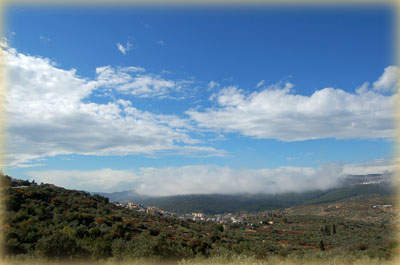 Surroundings of Mount Tabor © Photo of the orthodox pilgrim center "Russia in colors" in Jerusalem  View from the top of Mount Tabor on the Jezreel Valley and the city of Nazareth Photos January 26, 2014 © Photo of the orthodox pilgrim center "Russia in colors" in Jerusalem The Russian traveler and writer Andrei Nikolayevich Muravyov [47], who visited Palestine in 1830, also left a vivid memory from visiting Mount Tabor. "On the eve of the feast," writes Muravyov, "the monks of the Annunciation are flocking together with the Nazarene Christians to the sacred peak of Tabor, where they spend a summer night in a rest or prayer, charming under the sky of the East, surrounded by a bright current of stars." Before dawn, Tabor awakens them with a solemn hymn, and the sun rising from the mountains of Arabia, the first rays illuminate in the raised sacred cup the marvelous transformation of bread and wine into the redeeming Body and Blood, and before this great Mystery the embarrassed people are falling down prostrate, as if listening to the voice: "This e It is my Son, and it is my pleased "[48]. 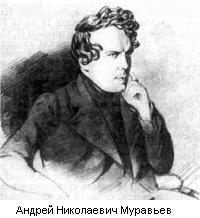 Andrei Nikolayevich Muravyov © Photo of the orthodox pilgrim center "Russia in colors" in Jerusalem Five years after Muravyov in 1835, the holy mountain Tabor is visited by another famous Russian writer and public figure - Avraham Sergeevich Norov [49], who recalled that "the remains of the church erected by St. Elena, still exist; under his lower vault, the Nazarene Christians serve once a year Mass, on the day of the Transfiguration of the Lord "[50]. In 1840, the Athonite priest of the monk Parfeny (Ageyev), visiting Mount Tabor, recalled how the worship took place: "As the sun rose, we ascended the mountain and found the very place where our Lord Jesus Christ changed before his disciples before This place was a great church; and where the Lord stood, there was an altar, and there was a throne, and now only the ground remains "[51]. This situation continues to remain throughout the 50s of the XIX century, and on this occasion wrote in the Russian press of that time: "There are ruins of two churches (Orthodox and Catholic) in Tabor, and both religions claim to unite the sacred point with their formless labors" [52 ]. Even then, finding the true place of the Transfiguration of the Lord aroused controversy in society. The Orthodox believed that the place was genuine in their own monastery, the Catholics in their own. This was discussed by the head of the Russian Ecclesiastical Mission in Jerusalem, Archimandrite Porphyry (Uspenskiy). "Each religion assimilates to its monastery a place where the Savior has changed. I neither affirm nor deny that tradition. It is enough for a Christian to believe that the Lord changed on the elevation of Tabor and pray for His enlightenment of the soul and for eternal salvation. And the event did not happen on one yard of the earth, but on the whole mountain. Light from afar was visible; the voice was heard far away; the cloud dawned all over the mountain; a voice from heaven was heard all over the mountain. So the whole mountain top is sacred "[53]. 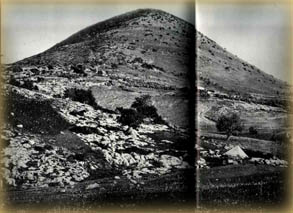 Mount Tabor. Photo of 1877 © Photo of the orthodox pilgrim center "Russia in colors" in Jerusalem Since 1854, the ruins of ancient monasteries on Mount Tabor began to attract special attention of Orthodox and Catholics. On this general wave of interest in the Holy Land, Archimandrite Irinarkh (1767-1859), a native of Moldavia, a native of the Roman village near Yass, a pupil of the disciples of the famous old man, Archimandrite Paisiy (Velichkovsky), first came here as a simple pilgrim. Since 1839, he decided to tie in prayer exploits in the Holy Land for the rest of his life and first settled in the Laura of St. Savva Sanctified in the Judean Desert, and then, wandering around Galilee, decided to settle with his spiritual child - an orphan, a native of his native village - Hierodeacon Nestor on Mount Tabor. These devotees of piety have arranged for themselves a cell in the so-called "cave of Melchizedek", next to the ruins of an ancient temple. The cave also exists on the present day on the right after the central entrance to the monastery. The devotees were fed with cereals and modest alms, brought by pilgrims. With their deeds and strictness of life, Russian monks scorned the respect of the local residents of the Bedouins and their leader Aqil-agi, who often came to the old man Irinarkh for advice and was ready to protect him from all dangers [54]. By chance, Archimandrite Irinarkh together with Hierodeacon Nestor find among the pile of stones the remains of an ancient temple with semicircular niches. Having arranged there an altar, the elder began to serve the pilgrims who came here. Pilgrims, whose number began to increase every day, donated money to the elder for the construction of the temple. The elder was also assisted by the acting Russian consular officer and agent of the Russian Society of Shipping and Trade in Kaifa[55], a local resident Constantine Averino, who collected a total of 14,000 piastres among the inhabitants of his land. The Patriarch of Jerusalem, Cyril II, also helped, sending a donation of 5,000 piastres to the construction and instructing the Jerusalem Patriarchate to help the old man as necessary. Thus, the eldest Irinarkh collected about 40,000 piastres and he began building the chuch, as well as three living rooms, a kitchen and a horse mill. The entire area of the land, occupied by the elder Irinarkh, was surrounded by a low wall [56]. 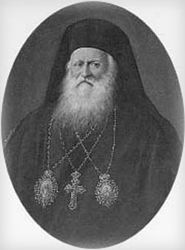 Jerusalem Patriarch Cyril II © Photo of the orthodox pilgrim center "Russia in colors" in Jerusalem Money for the construction of the church was not enough, again I had to turn to Bishop Kirill (Naumov), Bishop of Melitopol, the head of the Russian Ecclesiastical Mission in Jerusalem, who personally knew the 90-year-old Irinarkh. He presented to the Chairman of the Palestinian Committee, Grand Duke Konstantin Nikolayevich, a memorandum containing the circumstances of this case: "St. Tabor, sealed with a great gospel event, he wrote on September 15, 1859 in this note, but was unfortunately forgotten now and ignored by the local Orthodox authorities, while the Latins are already scampering around him, intensifying to take it; his own prey. Only the venerable hermit, ninety years old, comes from the Slavs, who came to Tabor because of his former vision, settled here and with his own hands revealing the ruins and rebuilding the ancient church. Without the assistance of the Greeks, despite the opposition of the Latins, among the Bedouin gangs (feeding, however, to him religious reverence, as a miracle-worker), this wonderful old man managed to put a good beginning already, using benefits only from our side. The whole place of the sacred ruins is surrounded by a wall, the ruins of the temple are cleared and in one ancient alcove the throne is already arranged, where the elder performs the priesthood. The templekeeper now asks for 30,000 piastres (about 1,500 rubles in silver.) In order to complete the building. Subsequently, the time will require, perhaps, still the same amount to supply the church with the iconostasis, which it would be nice to have from Russia, and utensils... Would it not be pleasing to His Imperial Highness to turn the August attention to the forgotten sacred Tabor and there to arrange a sacred monument of the happy events in his august family. Together with the manual, it would be possible to convey to the holy old man the idea of the arrangement in the church was specially given in the name of the Equal of the Apostles Constantine "[57].  Memorial Memorial Marble Plaque Arch. Irinarkh © Photo of the orthodox pilgrim center "Russia in colors" in Jerusalem  Miraculous akathist icon of the Mother of God, which is mistakenly called "Unfading color" Photos January 26, 2014 © Photo of the orthodox pilgrim center "Russia in colors" in Jerusalem Elder Irinarkh did not live to see the completion of the construction of the temple and its consecration. He went to the Lord on Christmas Day, December 25, 1859. The case was continued by his faithful disciple Hierodeacon Nestor, who received a testament from the old man to bring all the buildings to completion. Russian pilgrim V. Kaminsky, who visited Mount Tabor in April 1862, several months before the consecration of the chucrh, describes how the church looked then: "The building, he writes, is very good and extensive, in Greek taste, with three chapels, there is nothing inside. The two extreme side-chapels are completely open, the middle one, too, does not have an iconostasis, not even a veil that would replace it, but instead a wall was made of wood branches, a royal gate without gates at all, and not even hung with a veil, windows without glasses. In the lower part of the church heaps of lime are piled on, on the branches of the iconostasis there hang only three local icons: the Savior, the Mother of God and the Transfiguration, before them are two most simple candlesticks. The stone throne is naked and covered with the most scarce veil. Everything shows that the patriarchate does not take any part in the essential "[58]. 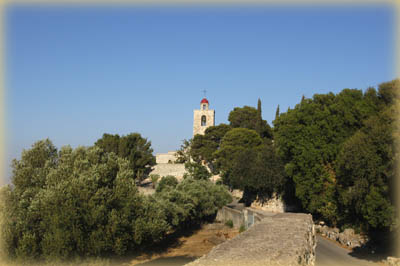 The road to the Greek Orthodox monastery on Mount Tabor © Photo of the orthodox pilgrim center "Russia in colors" in Jerusalem  The modern territory of the monastery. © Photo by V. V. Shelgunov © Photo archive of the Jerusalem branch of the IOPS  The modern territory of the monastery. Photos January 26, 2014 © Photo of the orthodox pilgrim center "Russia in colors" in Jerusalem  Orthodox church of the Transfiguration of the Lord. Photos January 26, 2014 © Photo of the orthodox pilgrim center "Russia in colors" in Jerusalem  Greek Orthodox monastery on the top of Mount Tabor. 2010 © Photo of the orthodox pilgrim center "Russia in colors" in Jerusalem  The interior of the Greek Orthodox church on top of Mount Tabor. 2010 © Photo of the orthodox pilgrim center "Russia in colors" in Jerusalem  Ruins of the Byzantine period of the IV century on the territory of the Greek Orthodox monastery Photos January 26, 2014 © Photo of the orthodox pilgrim center "Russia in colors" in Jerusalem August 6, 1862 according to art. style, on the feast of the Transfiguration of the Lord, the Patriarch of Jerusalem, Cyril II, arrived on the holy mountain of Tabor and solemnly consecrated the church together with the Greek metropolitans of Akra and Nazareth. Prior to this, the patriarch, preparing the church for the upcoming celebration on July 17, ordered the body of Archimandrite Irinarkh, buried in 1860 inside the church on the right side of the entrance doors, outside the line of the altar and the iconostasis, removed from the earth and put in the grave outside the church, to the right of entrance doors. This order of the patriarch, disturbing the ashes of all the venerable old man, made a very difficult impression not only on the Orthodox, but even on the Bedouin Muslims [59]. New donations from Russia were used for the interior decoration of the chuch. Thanks to the instructions and requests of the new head of the Russian Ecclesiastical Mission in Jerusalem, Archimandrite Antonin (Kapustin), the former Russian ambassador in Constantinople, Count N.P. Ignatyev in 1869 obtained from the Russian government for the Tabor monastery 2,000 rubles [60]. Traces of ancient structures were preserved in the altar apse of the church. The church is three-pedestal: the central one is dedicated to the Transfiguration of the Lord, the right one - to the prophets Moses and Elijah, the left one - to George the Victorious and Dmitry Solunsky. In Archondarik [61] for the pilgrims near the church there is an icon of the Transfiguration - a gift of the Grand Duke Sergius Alexandrovich - chairman of the Imperial Orthodox Palestine Society and his wife Grand Duchess Elizabeth Feodorovna during their visit to Mount Tabor in 1888. 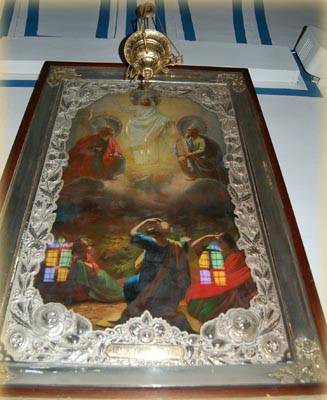 The icon of the Transfiguration, donated by the Grand Duke Sergiy Alexandrovich © Photo of the orthodox pilgrim center "Russia in colors" in Jerusalem 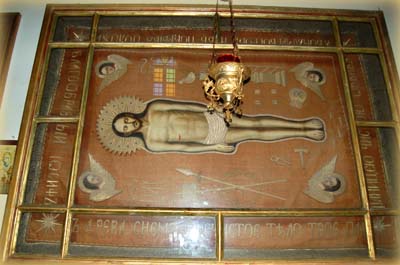 Russian Shroud - a gift of pilgrims from Russia © Photo of the orthodox pilgrim center "Russia in colors" in Jerusalem The government bulletin from September 29 to October 6, 1888, tells of the visit of Mount Tabor to Grand Dukes Sergiy and Pavel Alexandrovich and Grand Duchess Elizabeth Feodorovna: "The Grand Dukes and the Grand Duchess, except Constantinople, visited Smyrna, to Jerusalem, the ruins of Ephesus, Beirut, the ruins of Baalbek, Damascus, Kaifa, Nazareth, Kana Galilei and Tabor, and everywhere He was provided not only officially-solemn, but quite enthusiastic reception. Not to mention the local authorities who have done everything in their power to fulfill exactly the instructions of their master, one can not help but pay attention to local residents who with genuine enthusiasm everywhere met the August Travelers: all trips of Their Highnesses through Syria and Palestine were marked by a series of triumphal processions: ovations were mixed positively all without distinction of nationality: Greeks, Turks, Arabs, Jews "[62]. The original place of the burial of the Elder Irinarkh was marked by a memorial marble plaque to the right of the altar of the chapel of prophets of Moses and Elijah. The monastic bell tower rises above the gate of the fence. It was erected on the donations of the Russian benefactress Olga Kokina [63]. The courtyard and adjoining fences are planted with cypresses, fig trees and olives, giving a pleasant shade. The Greek monastery gave shelter to the 400th Russian pilgrims, for which vaulted halls were built behind the church [64]. From the church shrines to this day is especially revered akathist icon of the Mother of God, located on the left at the entrance to the church. Near the church is the cave of Melchizedek, in the vicinity of which, according to tradition, Melchizedek met the forefather of Abraham with bread and wine. [65]  Belfry built on donation Russian benefactress Olga Kokina Photos January 26, 2014 © Photo of the orthodox pilgrim center "Russia in colors" in Jerusalem  The new belfry of the monastery, arranged in 2012 Photos January 26, 2014 © Photo of the orthodox pilgrim center "Russia in colors" in Jerusalem  A new chapel on the territory of the Greek Orthodox monastery, built in the 21st century, Photos January 26, 2014 In 1872, an interesting historical reference to the visit to Mount Tabor is left by the military historian and memoirist, adjutant of Grand Duke Nikolayevich the Elder in his travel diary "Journey to the East and the Holy Land in the retinue of Grand Duke Nikolai Nikolaevich in 1872 D.A. Skalon St. Petersburg 1881»[66]. The retinue of Grand Duke Nikolai Nikolaevich included famous people of that time: the princes Oldenburg Alexander Petrovich and Konstantin Petrovich, Count G.A. Stroganov, generals D.I. Skobelev, M.N. Dohturov, V.N. Sipyagin, A.A. Gull et al. [67]. Here, as describes D.A.Scalon them visiting Mount Tabor: "Three hours later Tabor appeared and we saw the train of His Highness approaching his sole. Favor stands among the valley, famous for its fertility and the multitude of battles. It rises 1,000 feet above the surrounding terrain and from all sides looks like a truncated cone, the ramps of which are covered with various shrubs, wild pistachio, acacia with an extremely large leaf and oak, a rare clumsy forest.It is noteworthy that five years later these military men who made a pilgrimage to the Holy Land take an active part in the military operations of the Russian army in the Balkans under the command of Grand Duke Nikolai Nikolayevich the Elder. Somewhat later, after the Orthodox construction on Mount Tabor was carried out, work began by Catholic Franciscan monks, to restore the ruins of the remaining crusaders and even more ancient buildings. In 1873 they built a small chapel on the site of a monastery built by Tankred. Russian pilgrims who visited Tabor reported that the Catholic monastery on Tabor was very modest in those years [69]. About this writes, for example, the priest Alexander Anisimov from the Kharkov province, honored to visit Tabor in 1881. When he approached the Catholic monastery with his companions, the Franciscan monk who came out to meet them invited the Russian pilgrims to examine the Catholic chapel. "It is small and has the appearance of a chapel," O. Alexander writes. - We did not notice anything particularly remarkable about it, except for the wonderful icon of the Transfiguration of the Lord, composed of colors of an icon of colored stones selected by color "[70]. The Catholics repeatedly conducted systematic archaeological excavations on their site and in 1889 one of the Russian authors reported: "Most of the ruins are in the hands of Catholics; there everything is excavated, cleaned and kept in exemplary order; only a few months ago they excavated a part of the hill where the remnants of a fairly well-preserved room were found, adjacent to the church, which served as a place of rest for the worshipers. "[71]  Archaeological excavations in a Catholic monastery on the top of Mount Tabor Photos January 26, 2014 © Photo of the orthodox pilgrim center "Russia in colors" in Jerusalem  Territory of the Catholic Monastery on the top of Mount Tabor Photos January 26, 2014 © Photo of the orthodox pilgrim center "Russia in colors" in Jerusalem In 1913, the famous Russian church historian and secretary of the Imperial Orthodox Palestine Society Alexei Afanasievich Dmitrievsky wrote: "The Catholics should be considered the owners of the place of the Transfiguration of the Lord on Tabor. For this speak the majestic, truly monumental ruins of the vast ancient Christian structures, which here are indisputably the result of the most important and ancient Christian traditions associated with this sacred place "[72]. In 1919-24, the famous Italian architect Antonio Barluzzi, along with his brother Giulio, built the Franciscan basilica of the Transfiguration on the top of Mount Favor. Architect Antonio Barluzzi  Memorial plaque to the architect of the Catholic basilica - Italian architect Antonio Barluzzi (1884-1960) Photos January 26, 2014 © Photo of the orthodox pilgrim center "Russia in colors" in Jerusalem In the guidebook of Bishop Methodius (Kulman) this basil is described as follows: "A beautiful fasade arises from the surrounding masses of dark stone, the numerous ruins of individual buildings, churches and cells. Apparently, here were observed in the Middle Ages 4 churches. Two towers of the facade to the right and left of the entrance stand above the chapels - one in the name of Elijah, and the other - of Moses, in place of the ancient ones dedicated to them, small churches. From here the colossal ship of the basilica leads to the main altar, where several marble steps lead down, to the ancient level of the place - here you can see the stones of the original Byzantine basilica "[73]  The Catholic Basilica of the Transfiguration of the Lord on Mount Tabor, built by Italian brothers architects Antonio and Giulio Barluzzi in 1919-24 Photos January 26, 2014 © Photo of the orthodox pilgrim center "Russia in colors" in Jerusalem  Interior of the Catholic Basilica of the Transfiguration on Mount Tabor Photos January 26, 2014 © Photo of the orthodox pilgrim center "Russia in colors" in Jerusalem
Chapel of the Prophets of Moses and Elijah within the complex of the Catholic Basilica of the Transfiguration. Photos January 26, 2014 © Photo of the orthodox pilgrim center "Russia in colors" in Jerusalem An interesting description of both Mount Favor and the Orthodox and Catholic monasteries is given in his pilgrimage diary "A Vacation in the Holy Land" (1899) by the teacher of the Kiev Theological Seminary Pavel Petrushevsky. He visited the Holy Land in the summer of 1899, experiencing not only the spiritual need of pilgrimage, but also as a person writing scientific curiosity, as the author himself notes, "going to the Orthodox East and mainly to the Holy Land, I wanted to find there a real substantive basis for biblical and church-historical paintings, images, characteristics and explanations "[74]. Having such a profound inner approach in his visit to the shrines of the East, Pavel Petrovich leaves a vivid memory of the visit of Mount Tabor in 1899: "Tabor now stood before us in all its glory; On the slope it is covered with forest, only not as dense as ours, but rare, for its stony ribs allow it to grow trees only a certain distance from one another. The mountain really does stand as if apart from others, but not completely it is also isolated. In connection with it to the west there is another hill, also covered with forest. It stretches as far as Nazareth and borders the Ezdrela Valley from the north. However, between this elevation and Tabor there is a narrow road, halfway around it from the west; another such valley encircles it from the north. From the east and south the mountain steeply descends into the Ezdrelonsky valley. To reach Tabor, we had to go down to the valley, which surrounds Tabor from the north. When descending to the valley stands a dilapidated Arab fortress. In the walls of her strelnitsy and the gate. Our conductor informed us that recently an annual fair was held here. Now this does not happen here either. Then we went north valley. From it they began to climb upwards, along the cleft, separating the western hill from Mount Tabor. The road was very picturesque. The oak forest grows on both sides. The oak tree here is not tall, its branches are not as ramshackle as ours. The leaves are also narrow, like that of Mamvri, but the caps of the acorn are wider; The acorn itself is smaller than that of Mamvri. Ground, by which we go, volcanic rock; in the places visible from the road are the cracked rocks. Half an hour later we turned left and began climbing Tabor. The road to the mountain was carried out by zigzags, from the south-west. It is very convenient for pedestrians and horse riding, but not for the crew. To the very top we go among the shallow, mostly oak forest. Our tired and weak horses (I and the student) are sluggish; but our third companion Kezma has gone far ahead. At one of the turns, we suddenly caught up with him. He stood on a rock facing the Ezdrelonsky valley and invited us to admire this wonderful view of the surrounding area. The place was very convenient for viewing a huge plain spreading at the foot of Tabor. We climbed the stone platform of a steep cliff. We have an extensive view of the whole neighborhood from the south and west. At the foot of the mountain was the village of Daborria. This area resembles the prophetess of Deborah, who once shared with Barak the honor of victory over the seats of Jabin, king of Asor. At the very foot of the mountain, far in the direction from east to west stretched the vast valley of the Ezdrelonskaya. It was all sown with bread and tsizam [75]. On the other side of the valley this is confined to the mountain of Malyi Yermon and the Gelwuy mountains. Far to the west at the foot of Gelwuya is seen the village of Nain, where the Savior raised his son from a widow, and a little closer to the south-west, at the foot of the Gelwuyski mountains, the village of Aendor, where Saul went to ask the sorceress about the outcome of his wicked war with the Philistines. At the sight of the lifeless and bare slopes of these mountains, I involuntarily recalled that terrible, fatal battle with the Philistines, in which the beautiful sons of Israel perished in the heights of the Gelvuy, and I involuntarily uttered the words of the weeping David: "The mountains of Gilboi, let it not rain upon you, and yes do not fall dew on you "... To this colorful and distinctive story one can add an interesting fact that Pavel Petrovich's companion was his pupil at the Kiev Theological Seminary Taufik Kezma - the younger brother of the famous Alexander (Iskander) Kezma director of the Nazareth Seminary of the Imperial Orthodox Palestine Society. Taufik Kezma subsequently moves to Russia in Kiev and becomes known as an Orientalist [78]. Taufik Gavrilovich Kezma Every year, on the feast of the Transfiguration of the Lord on the night of August 18-19, a new style of Holy Mount Tabor is visited by many Orthodox pilgrims from all over the world. Here the Jerusalem Greek Patriarchate, headed by the Patriarch of Jerusalem, hosts a solemn festive divine service, usually not in the church itself, but in front of it on a specially constructed platform with an arranged altar, in view of the fact that the church is unable to accommodate all those who wish to participate in the celebration of the feast Transformations. Many believers testify to the wonderful Tabor cloud that descends after the Liturgy to an Orthodox monastery. The Orthodox see this as a sign of the special grace of God. © The Orthodox Pilgrim Center "Russia in Paints" in Jerusalem © Pavel Viktorovich Platonov, Chairman of the Jerusalem Branch, member of the Board of Trustees Of the Imperial Orthodox Palestine Society Jerusalem Herald of the Imperial Orthodox Palestine Society. Issue No. VII-VIII. 2015 Publishing house: Jerusalem Department Jerusalem. ISBN 978-965-7392-77-5 Pages 233-256 Notes [1] (Holy Gospel of Matthew 17: 5-9) [2] Works of Origen. Comm. in Ps. lxxxviii, 13 [3] St. Cyril of Jerusalem. Catechetical conversations. II. 16 [4] The Blessed Jerome of Stridon. 46 Epistle, 53 and 108. [5] The tradition of the Christian pilgrimage to Mount Tabor begins from the IV century. [6] "In view of the prevailing importance of Mount Tabor over the surrounding area, this mountain was of a military-strategic importance. There were Roman fortifications. Therefore, some scholars do not want to see Mount Tabor in the "high mountain", but prefer it to the parallel Mount Hermon, as more remote from the world of the world and convenient for the solitary prayer of our Savior and His glorious Transfiguration. But these scholars ignore the words of the apostle Peter, addressed in the admiration for the Savior: "Lord, it is good for us to be here. If you want, we will make here three tabernacles: To you alone, and to Moses alone, and one to Elijah. " (Matthew XVII, 4). No matter how ardently enthusiastic St. Apostle Peter, he could hardly have chosen the place of permanent residence of the neighboring Hermon, from which, moreover, there is no way to contemplate those charming pictures of nature that are actually opened from the top of the blessed (1,100 feet of height) in climatic terms and rich in vegetation and moisture Tabor ". Quoted on the "Feast of the Transfiguration on Mount Favor". Professor AA Dmitrievsky. Edition IOPS. SPb 1913. Internet publication on the website "Russia in colors" http://ricolor.org/russia/9/9/ May 2005 [7] The division of land between the Israeli tribes of the 12th-11th centuries. BC. See the map. [8] Chaim Herzog, Mordechai Gishon. Biblical battles. Moscow. 2006 The Astrel Publishing House. Ñòð. 65. [9] Ibid. [10] Vladimir Tsyvkin. "In the footsteps of Jesus in the Holy Land. Mount Tavor and its history. " Jerusalem. Ñòð. 218. [11] Chaim Herzog, Mordechai Gishon. "Biblical battles." Moscow. 2006 The Astrel Publishing House. Ñòð. 66. [12] Ibid. [13] Gnaeus Pompeius the Great, or Gnaeus Pompeius Magnus (Latin Gnaeus Pompeius Magnus, 106 BC - 248 BCE) is an ancient Roman statesman and commander, consul of the Roman Republic 70, 55 and 52-ies BC, commander loyal to the Senate troops in the civil war of 49-45 years BC. [14] Josephus of Flavius. "The Jewish War". Ed. "Folio". Kharkiv. The first book. Chapter eight. Ñòð. 36. [15] Josephus of Flavius. (Josephus Flavius) Yosef ben Matityahu (circa 37 - ca 100), a Jewish historian and military commander. Joseph came from a noble family of priests, at the age of 19 he joined the Pharisees and became an influential man in Judea. About 64 visited Rome, wishing to obtain from Nero the liberation of several notable Jews. The power and cultural superiority of the Romans made a huge impression on Joseph. On his return to Jerusalem, he discovered that the Jews were preparing to rebel against Roman rule, and, not being enthusiastic, was forced to join them. Joseph was entrusted with the defense of Galilee, ie. northern part of Palestine, but his actions were unsuccessful, and, withstood a 47-day siege in the city of Iotapata, he was captured in 67 by the future emperor Vespasian. To save his life and help his compatriots after their inevitable defeat, Joseph offered his services to Vespasian and until the end of the war he was an interpreter for him and Titus, as well as an intermediary between the Romans and the Jews. After the fall of Jerusalem in 70 Joseph went to Rome, where he received Roman citizenship and a pension. Joseph is known for having survived in the Greek language works - the Jewish War (about the uprising 66-70) and the Jewish Antiquities. (Encyclopedia "Krugosvet") [16] Josephus of Flavius. "The Jewish War". Ed. "Folio". Kharkiv. Ñòð. 36, p. 261. [17] Ibid. The fourth book. Chapter first. Ñòð. 261 [18] The Gospel of Matthew (16, 21-28), the Gospel of Mark (8, 31-39). [19] The Gospel of Luke (9, 22-27). [20] A. A. Dmitrievsky. "Feast of the Transfiguration on Mount Tabor". 1913 year. Edition of the Imperial Orthodox Palestine Society. Internet publication on the website "Russia in colors" http://ricolor.org/russia/9/9/ May 2005 [21] The Gospel of Luke (9, 32). [22] Tobler et Molinier. Itinera Hierosolymitana t. l, pag. 94. Qu. on the specified product of AA Dmitrievsky. [23] A. A. Dmitrievsky. The specified product. http://ricolor.org/russia/9/9/ May 2005 [24] The Gospel of Luke (9, 39). [25] Archimandrite Augustine (Nikitin). "Russian pilgrims near Catholic shrines." Favor. The Church of the Transfiguration. [26] Vladimir Tsyvkin. "In the footsteps of Jesus in the Holy Land. Mount Tavor and its history. " Jerusalem. P.220 [27] Beda Venerabilis, 674-735, a church historian, monk, author of Historia ecclestastica gentis Anglorum, the only source of the most ancient history of England until 731 (published by Holder, 1890, and Plummer, 1816). (Small Encyclopedic Dictionary of Brockhaus and Efron) [28] Ibid pag. 230. Cit. on the specified product of A.A. Dmitrievsky. [29] Ibid pag. 260. Cit. on the specified product of A.A. Dmitrievsky. [30] This definition fully corresponds to the current situation of the Greek church in the name of the Transfiguration of the Lord. Quoted on the specified product A.A. Dmitrievsky. [31] Orthodox Palestine Collection of III and IX centuries. 111-115, St. Petersburg. 1885. It is quoted from the above-quoted product of A.A. Dmitrievsky. [32] Tankred († 1112) is the nephew of Bohemond of Tarentum, one of the heroes of the First Crusade. [33] Archimandrite Augustine (Nikitin). The specified product. [34] Saewulf, an Anglo-Saxon whose work on the journey to the Holy Land, representing a very important historical source, was preserved in a single manuscript of the 12th century in the library of the Corpus Christi College of Cambridge University. He traveled in 1102-1103. The Russian translation of his travel was made by P. Bezobrazov ("Collection of the Orthodox Palestine Community" volume III, issue 3); In the foreword of the translator, foreign publications and literature are indicated. Encyclopedic Dictionary of Brockhaus and Efron (1890-1907). [35] Orthodox Palestine collection. St. Petersburg. 1885 "The Journey of Zevulf to the Holy Land 1102-1103" [36] The Orthodox Palestine Collection in. XXIII (v. VIII, v. II) p. 8 - 9, 37- 38. St. Petersburg. 1889. Quoted on the specified product of A.A. Dmitrievsky. [37] Salah-ad-Din, Saladin, Yusuf ibn Ayub (1138 - 4.3.1193, Damascus), ruler of Egypt from 1171, founder of the Ayyubid dynasty. Kurdish by origin. Son Ayyub ibn Shadi - one of the commanders of the Syrian sultan Nur-ad-din, who successfully fought against the Crusaders. In 1164-69 he participated in military campaigns against Egypt. In 1169 he was appointed a vizier of Egypt, and in 1171, after the death of the last caliph of the Fatimid dynasty, seized power in Egypt and proclaimed the suzerainty of the Abbasids, having obtained from them in 1174 the title of sultan. After the death of Nur-ad-din in 1174-86, he subdued his Syrian possessions and some possessions of small Iraqi rulers. July 3-4, 1187 army Saladin defeated the Crusaders under Hittin (Palestine), October 2, 1187 took Jerusalem, then drove out the crusaders from the greater part of Syria and Palestine. His domestic policy was characterized by the development of the military-political system, a certain reduction in taxes, and the strengthening of Sunni orthodoxy. (TSB). [38] Vladimir Tsyvkin. "In the footsteps of Jesus in the Holy Land. Mount Tavor and its history. " Jerusalem. P.220 [39] The battle of Hittin (modern name in Hebrew of this place in Lower Galilee - קרני חיטין - Karnei Hittin - "Horn of Hittin") - the battle that took place July 4, 1187 between the Jerusalem kingdom of the Crusaders led by King Guy de Lusignan and forces of the dynasty Ayyubidov . The Crusaders were defeated by the Muslim armies under Saladin. [40] Ptolemaic - Hellenistic name of the city of Acre in the IV-II centuries. BC. e. [41] The Orthodox Palestine Collection vol. XIV, Issue. 1, p. 2, 11, St. Petersburg. 1895 [42] This product is AA. Dmitrievsky. [43] Archimandrite Augustine (Nikitin). The specified product. [44] The wanderings of Vasily Grigorovich Barskiy to the holy places of the East from 1723 to 1747. C.P. St. Petersburg, 1886, p.148 [45] Napoleon. Selected works. - Moscow: Military Publishing, 1956, Ch. 10. http://militera.lib.ru/science/bonapart/-10.html [46] Archimandrite Augustine (Nikitin). The specified product. [47] Muraviev Andrei Nikolaevich - writer (1806 - 1874). [48] A Journey to St. Mestam in 1830. Quoted from the Pilgrim's Companion to the Holy Places of Bishop Methodius (Cullman). From the book "Holy Land". Paris 1961 [49] Norov Avraham Sergeevich - statesman and writer (1795 - 1869). [50] Norov A.S. Journey to the Holy Land in 1835. Parts 1-2. Ed. 3rd. St. Petersburg, 1854, p.208. [51] Legend about the journey and travel around Russia, Moldavia, Turkey and the Holy Land of the venerable priest of Mount Athos Mountains of the monk Parfenia. M., 1856, p.93 [52] B.P. Mansurov. Wandering to Palestine. (m, b), p.138. Cit. Archimandrite Augustine (Nikitin). The specified product. [53] Porphyry (Uspenskiy), Bishop. The book of my being. T.I. St. Petersburg, 1894, p. 531. [54] This work by A.A. Dmitrievskii. [55] Kaifa - the so-called in the XIX century the city of Haifa. [56] Ibid. [57] Case of the Palestinian Committee No. 15 (formerly Asian Decree No. 926) p. 3 v / v. Cit. on the specified product of A.A. Dmitrievsky. [58] 2 hours. Memoirs "for the years from July 1, 1861 to April 17, 1864" by V. Kaminsky manuscript of the Library of the Imperial Orthodox Palestine Society. Cit. on the specified product of A.A. Dmitrievsky. [59] Case of Pal. Committee No. 15 (Az., No. 926) f. Cit. on the specified product A.A. Dmitrievsky. [60] A. Dmitrievsky, "Count N.P. Ignatyev, as a Church and Politician in the Orthodox East", St. Petersburg. 1909 page 28. [61] Archondarik or fondarik (Greek αρχονταρικόν, from άρχοντας - aristocrat, nobleman) - a reception room for guests in an Orthodox monastery, also a hotel for pilgrims, usually in Greece (on Mount Athos, Meteora), in Greek monasteries Saint Earth or in Egypt (Sinai Monastery). In the archodarik, spiritual conversations with pilgrims are also conducted. The name comes from the Greek word archon, meaning the eminent visitor of the monastery, who was received with special honor. [62] Journey to the Holy Land of the Grand Dukes of Sergius and Paul Alexandrovich and Grand Duchess Elizabeth Feodorovna. Government Gazette, St. Petersburg, October 27, 1888 WUA RI, RIPPO, op. 873/1, d. 293, p. 47-48 vol. Russia in the Holy Land. Moscow. International relationships. 2000. Ñòð. 160-161. [63] N. N. Lisovoi. "The testimony of God on earth. Favor is the mountain of the Transfiguration. " M-va. 2000. Edition of the ROC. Ñòð. 99. [64] Pilgrim's companion to the Holy Places of Bishop Methodius (Kuhlman). From the book "Holy Land". Paris 1961 [65] Genesis (14:18) [66] D.A. Scalon. "Journey to the east and the Holy Land in the retinue of Grand Duke Nikolai Nikolaevich in 1872. D. A. Skalona. St. Petersburg 1881 Russia in the Holy Land. Moscow. "International relationships". 2000. 135 [67] D.A. Scalon. "Journey to the east and the Holy Land in the retinue of Grand Duke Nikolai Nikolaevich in 1872. D. A. Skalon. St. Petersburg 1881 Moscow. Publishing house "Indrik". 2007 [68] D.A. Scalon. "Journey to the east and the Holy Land in the retinue of Grand Duke Nikolai Nikolaevich in 1872. D. A. Skalon. St. Petersburg in 1881, "Indrik". Moscow. 2007. Ñòð. 118. [69] Archimandrite Augustine (Nikitin). The specified product. [70] Anisimov A., priest. Travel notes of the Russian pastor about the sacred East. Ed. The 2 nd. St. Petersburg, 1889, pp. 320-321. Cit. Archimandrite Augustine (Nikitin). The specified product. [71] Yakubovich A.I. Walking through Palestine. [72] Dmitrievsky A.A .The Feast of the Transfiguration on Favor. St. Petersburg, 1913, p. 27. [73] Pilgrim's companion to the Holy Places of Bishop Methodius Cullman. From the book "Holy Land". Paris 1961 [74] "A vacation trip to the Holy Land" (1899). Pilgrimage diary with five drawings. Kiev. The printing house of the Imperial University of St. Vladimir. 1904. 2. [75] This is a plant in the genus of flax; from its very fine grains they make halva, lean oil, etc. (Note by P.P. Petrushevsky) [76] It means Kfar-Kama is a Circassian village founded in the XIX century, natives of Russia and existing to this day. [77] "Vacation trip to the Holy Land (1899). Pilgrimage diary with five drawings. Kiev. Printing house of the Imperial University of St. Vladimir. 1904. 341-347. IOPS archive at Sergievsky Compound in Jerusalem. [78] He was born in 1882 in Damascus, Syria. He graduated from Nazareth Seminary. He graduated from the Kiev Theological Seminary and the Kiev Theological Academy (1906). Since 1907 - assistant vice-rector of the Kiev University St.. Vladimir, taught the Church Slavic language, Greek, Hebrew, Latin. From 1913 to 1915 he was a supernumerary teacher of the Arabic and Türkic languages of the Kiev Commercial Institute. In 1914 he was in Persia, where he perfected Persian speech. Since 1917 he also taught Turkish and Persian languages. In the Soviet period, a researcher at VUAN, he studied Arabic philology. The result of his scientific activity was the creation in 1920-1930-ies together with Agafangel the Crimean Ukrainian orientalist school and the training of experts-orientalists, diplomats and scientists. "The value of Arabic studies for the orientalist," wrote T. Kezma, "and a number of other scientific ones is difficult to overestimate. It is known that the works of historians and geographers writing in Arabic are one of the most valuable sources for studying Kievan Rus, the international ties of this most powerful Slavic state, the life and way of life of the ancient Slavs, the origin of writing in Russia ... The study of the Arab East has great value ". He highly appreciates the textbook of the Arabic language written by him. For 40 years (with interruptions) he taught Arabic to students of Kiev universities and post-graduate students of the Academy of Sciences. In the 1930s, he was fired from his job "for lack of scientific qualification," AE Krymsky tried to restore justice. In 1938 - 1939 - was arrested. After the war, a stream of young people, wishing to learn Arabic and Turkish, flows to him, in his "cell on Andreevsky". Until his death, Taufik Kezma was the headman of St. Andrew's Church. Until 1958 he taught Arabic philology at the Kiev State University. T.G. Shevchenko. In 1958 he died in Kiev. He was buried in the Baikovo cemetery. Fragment from the monograph: Dialogue of civilizations: basic concepts, ideas, technologies. Monograph. Qty. avt .; Under the general editorship of Academician OA Kolobov. - Beirut / Nizhny Novgorod: Izd-vo MIM "Makhinur", 2006.- p. 472 Chapter IV. Interaction of cultures. § 7. Diaspora of the Levant in the Slavic Sociocultural Continuum, pp. 314-325. Publication on the website "Russia in colors" January 28, 2012 http://ricolor.org/russia/6/28_01_2012/ |
| © 2005 The Orthodox Scientific Educational Society "Russia in colours" in Jerusalem |
||